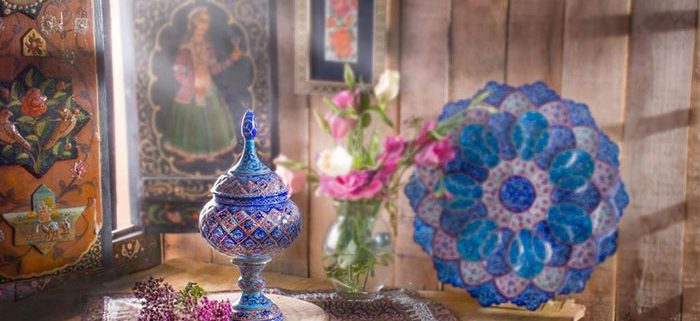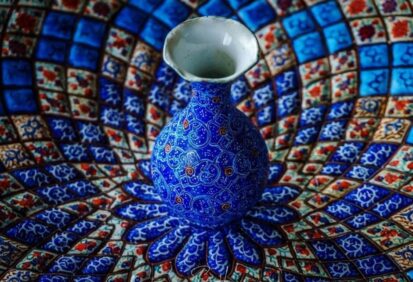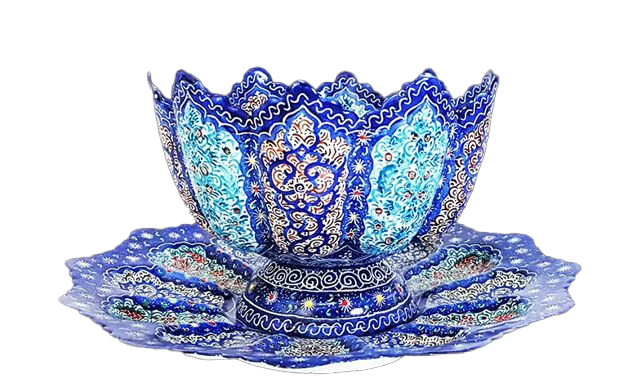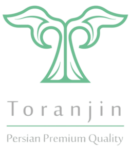
Mina kari art in the past and present
Minakari, also known as Meenakari or Enamelwork, is a traditional Persian art form that involves the intricate decoration of metal objects with colorful enamel. The word “Minakari” comes from the Persian word “mina,” which means enamel.
Minakari has a long history dating back to ancient Persia and has been practiced for centuries in Iran, India, and other parts of the world. It reached its peak of popularity during the Safavid dynasty in the 17th century.
Minakari is commonly used to decorate a wide range of objects, including jewelry, vases, plates, bowls, and decorative items. The designs often feature intricate floral patterns, geometric motifs, or scenes from nature and mythology. The artistry and skill required to create Minakari pieces make them highly valued and sought after.
Mina Kari in today
Today, Minakari continues to be practiced by skilled artisans in Iran and other parts of the world. It represents a beautiful and enduring tradition of craftsmanship and artistic expression.
Minakari art is known for its intricate designs, meticulous craftsmanship, and vibrant color combinations. Traditional motifs include floral patterns, geometric shapes, and intricate Persian calligraphy. The art form has been used to decorate a wide range of objects, including jewelry, vases, bowls, plates, and decorative pieces.
Minakari has a long history in Persian and Islamic art and has been practiced for centuries. It continues to be a revered art form, with skilled artisans preserving and passing on the traditional techniques from one generation to the next. Today, Mina kari products are highly valued as exquisite examples of Persian craftsmanship and are sought after by collectors and art enthusiasts worldwide.
In the new era, Minakari continues to be a cherished art form and is practiced by skilled artisans in Iran and other parts of the world. While the traditional techniques and designs remain intact, contemporary artists have also introduced innovative approaches and incorporated modern elements into their Minakari creations.
In recent years, there has been a growing interest in reviving and promoting traditional crafts, including Minakari, as a means of preserving cultural heritage and supporting local artisans. Various initiatives have been undertaken to showcase and market Minakari products, both domestically and internationally, through exhibitions, trade fairs, and online platforms.
Additionally, contemporary artists and designers have been experimenting with new materials and styles to bring a fresh perspective to Minakari. They may combine enamelwork with other mediums like wood, glass, or even incorporate Minakari designs into contemporary jewelry and home decor items. This fusion of traditional and modern aesthetics has helped Minakari gain appreciation from a wider audience.
Moreover, advancements in technology have also impacted Minakari in the new era. Techniques such as laser cutting and digital design tools are being used to create precise patterns and intricate details, enhancing the overall quality and efficiency of the Minakari process.
Overall, while preserving its traditional roots, Minakari in the new era embraces innovation, creativity, and the evolving tastes of art enthusiasts, ensuring its continued relevance and appeal in the contemporary world.

The process of creating Minakari
Minakari involves the art of coloring and ornamenting the surface of metal objects, typically copper or silver, with vibrant and intricate designs. The process of creating Minakari involves several stages, including:
- Metal Preparation: The metal object, usually a vase, plate, or jewelry piece, is first shaped and polished to create a smooth surface for the enamel.
- Engraving: Skilled artisans engrave intricate designs or patterns onto the metal surface using small chisels or hand tools. These designs often feature floral motifs, birds, geometric shapes, and calligraphy.
- Applying Enamel: Different colored enamels, usually in powdered form, are mixed with a binding agent to create a paste. This paste is carefully applied to the engraved areas of the metal object.
- Firing: The enamel-coated metal object is fired in a kiln at high temperatures, typically around 800 to 900 degrees Celsius. This process melts the enamel and fuses it onto the metal surface, creating a smooth and glossy finish.
- Painting and Firing (optional): After the initial firing, additional layers of enamel can be applied, and the process of firing and painting can be repeated to achieve multiple colors and intricate details.
- Polishing: Once the enameling process is complete, the metal object is polished to bring out the shine and highlight the vibrant colors of the enamel.

Isfahan and Mina Kari
Isfahan, Iran, is renowned for its rich history and cultural heritage, including its association with Minakari. The city has long been a center for the production of exquisite Minakari artwork, attracting visitors from around the world.
Isfahan’s Minakari artisans are known for their exceptional craftsmanship and attention to detail. They create a wide range of Minakari products, including decorative plates, vases, bowls, jewelry, and other ornamental items. The city’s bazaars and craft centers are filled with shops and workshops where visitors can witness the artistry firsthand and purchase Minakari pieces as souvenirs.
One of the most famous landmarks in Isfahan that showcases Minakari is the Imam Mosque (also known as Shah Mosque). This magnificent mosque, built during the Safavid dynasty, features stunning Minakari tilework on its exterior and interior surfaces. The intricate floral and geometric designs, adorned with vibrant enamel colors, exemplify the mastery of Isfahan’s Minakari artisans.
The Naqsh-e Jahan Square, a UNESCO World Heritage site located in Isfahan, is another prominent location where visitors can appreciate Minakari. The buildings surrounding the square, such as Ali Qapu Palace and Sheikh Lotfollah Mosque, boast elaborate Minakari decorations that add to the grandeur of the architecture.
Isfahan also hosts specialized Minakari workshops and training centers, where aspiring artisans can learn the traditional techniques from experienced masters. These institutions play a vital role in preserving and passing on the skills and knowledge of Minakari to future generations.
Overall, Isfahan’s association with Minakari is deeply ingrained in its cultural identity, and the city continues to be a significant hub for the production, promotion, and appreciation of this exquisite enamelwork art form.
All Types of Mina kari works
Minakari products encompass a wide range of decorative items and jewelry, each showcasing the intricate enamelwork and vibrant colors that are characteristic of this art form. Here are some examples of Minakari products:
- Plates and Trays: Minakari plates and trays are popular decorative items. They feature elaborate designs, often inspired by traditional Persian motifs such as floral patterns, arabesques, and geometric shapes. These pieces are typically displayed on walls or used as serving trays for special occasions.
- Vases and Bowls: Minakari vases and bowls are crafted with precision and adorned with intricate enamel designs. They come in various sizes and shapes, and their vibrant colors make them eye-catching decorative pieces for homes or offices.
- Jewelry: Minakari jewelry is highly sought after for its elegance and uniqueness. Enamelwork is applied to metal settings, creating beautiful pendants, earrings, bracelets, and rings. The enamel designs often incorporate floral patterns, miniature paintings, or calligraphy, adding a touch of sophistication to the jewelry.
- Boxes and Containers: Minakari boxes and containers are exquisite pieces used for storing precious items or as decorative accents. They are often embellished with intricate enamelwork and can feature hinged lids, compartments, or drawers.
- Home Decor Items: Minakari is also utilized in creating various home decor items such as candle holders, picture frames, decorative tiles, and wall hangings. These items add a touch of Persian artistry and color to any living space.
- Miniature Paintings: In some instances, Minakari is combined with miniature painting techniques to create miniature paintings on enamel surfaces. These delicate artworks often depict scenes from Persian literature, historical events, or nature.
These are just a few examples of the diverse range of Minakari products available. Whether it’s a small jewelry piece or a large decorative plate, Minakari products showcase the skillful craftsmanship and beauty of Persian enamelwork.
For purchasing the mina kari works click here.



Write a review